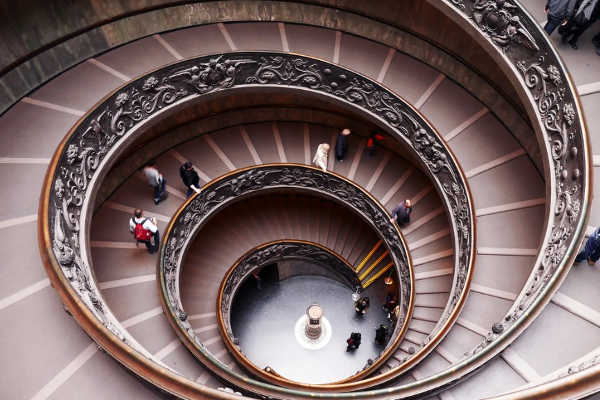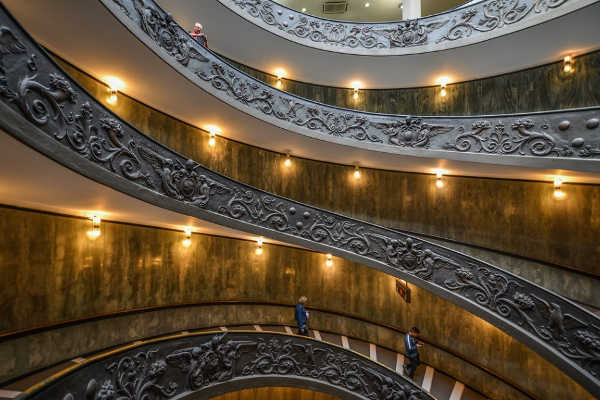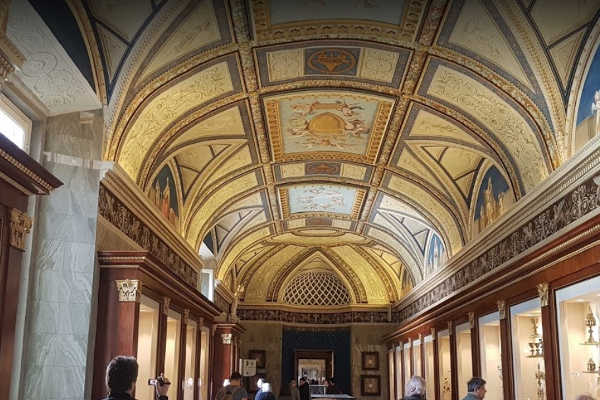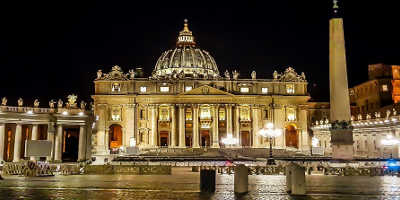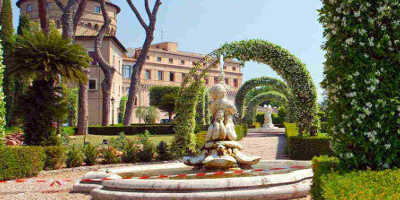Bramante Staircase, Vatican Museums
The Pio-Clementino Museum in Vatican City is home to a range of exceptional artwork and marvellous attractions, but few are as popular as Bramante’s Staircase.
There are, in fact, two staircases with the same name in the Vatican Museums. The original Bramante’s Staircase was built in 1505, while the modern one was built in 1932 and was based on the original. Seen as a revolutionary architectural wonder of that time, with the iconic spiralling structure which gained its popularity in past and present time.
The Original Bramante Staircase
Designed by the famous architect of Tuscany, Donato Bramante, the original staircase was commissioned by Pope Julius II in the early 16th century. The staircase features herringbone paving and has granite columns lining the innermost side of the spirals. It was built in a square tower and was designed to link the Belvedere Palace to the streets of Rome. It also allowed Pope Julius II to travel directly to his private residence by carriage. The reason this was possible is because the original staircase doesn’t have stairs but is more of a paved ramp. What’s more is that this fascinating architectural marvel displays the double helix shape. This is the shape we most commonly relate to a strand of DNA today. Naturally, this was not where the architect drew inspiration from as DNA was only discovered and observed centuries later. The real reason for this design was for convenience. It allowed traffic to travel up on one path and down on the other to ensure that there were never any interruptions. The original staircase is an exclusive destination which makes it very difficult to visit. However, to see this master craftsmanship on such an ancient structure is amazing, to say the least.
The Modern Bramante Staircase
Fortunately, the modern Bramante’s Staircase is entirely open to the public. Also located in the Pio-Clementino Museum, this staircase marks the end of a museum visit, and is the route that all visitors take when leaving the building. It really is quite something to stand at the very top of this enormous staircase and watch as streams of people descend to the ground floor. This staircase was designed by Giuseppe Momo in 1932 and displays very similar features to the original. It replicates the double helix shape, although in this instance it just allows two separate groups of people to descend together. However, it is not a ramp like the original, and does have low-profile steps for all the people who visit.
The Pio-Clementine Museum
The home of the Bramante staircase, the Pio-Clementine Museum was built in the 18th century and was commissioned by Pope Clement XIV. This museum displays a collection of sculptures that was originally started by Pope Julius II. The building was created by architects Alessandro Dori, Michelangelo Simonetti, and Giuseppe Camporese and was embellished by various artists and decorators. The collection was vastly expanded following excavations at various archaeological sites that unearthed Ancient Roman treasures that had been hidden for centuries. The museum not only displays these wonderful artefacts but has also restored many of them to their former glory. At the end of the 1700s, many of the artworks were removed and taken to Paris following the Treaty of Tolentino, however many of these have now been returned to the gallery.
How to see the Bramante Staircase?
Unfortunately, the original staircase is limited for viewing, only allowing an exclusive number of visitors. If you are lucky enough to view this ancient structure, you cannot walk along the ramps but can view the spirals from above. To marvel at the master craftsmanship on such an ancient structure is amazing, to say the least. The modern staircase is available to view and walk on throughout the week, acting as an exit/entrance to the museum. Take the iconic spiral photo of the stairs when you reach the very top.
Things to see near the Bramante Staircase
The Bramante Staircase is situated within Vatican City which has a wealth of other galleries to discover. Nearby to the Pio-Clementine Museum and Bramante Staircase is the Cortile Ottagonale, a beautiful courtyard, octagonal in shape and lined with beautiful arches and statues. Situated between the location of the staircase and St Peter’s Square is the Belvedere Courtyard which was also designed by Donato Bramante in 1505. Sometimes called the courtyard of the pinecone due to the pinecone-like sculpture at one end, this large square was commissioned by Pope Julius II to link the Villa Belvedere to the Vatican Palace. The original courtyard was designed in a tiered formation with different sections leading down from the Villa Belvedere. The courtyard now is far smaller, having been split by the Vatican Library which was built on the middle terrace. The lower courtyard remains the Belvedere Courtyard and the upper terrace is now the Cortile della Pigna. Amazingly, the lower part of the courtyard was often utilised by Pope Leo X who used to walk his elephant, Hanno, around the space for eager onlookers to see. The elephant was so adored that it is buried at the courtyard. That’s right, there is an elephant buried at the Vatican!
Other fantastic sights to see within easy reach of the Bramante Staircase are the Sistine Chapel, St Peter’s Basilica and Square, and the Raphael Rooms.
There are countless things to see and do in the Vatican City, with art, architecture and endless historical sights to see. Bramante’s staircase in the Pio-Clementino Museum is where all three of these things come together.

